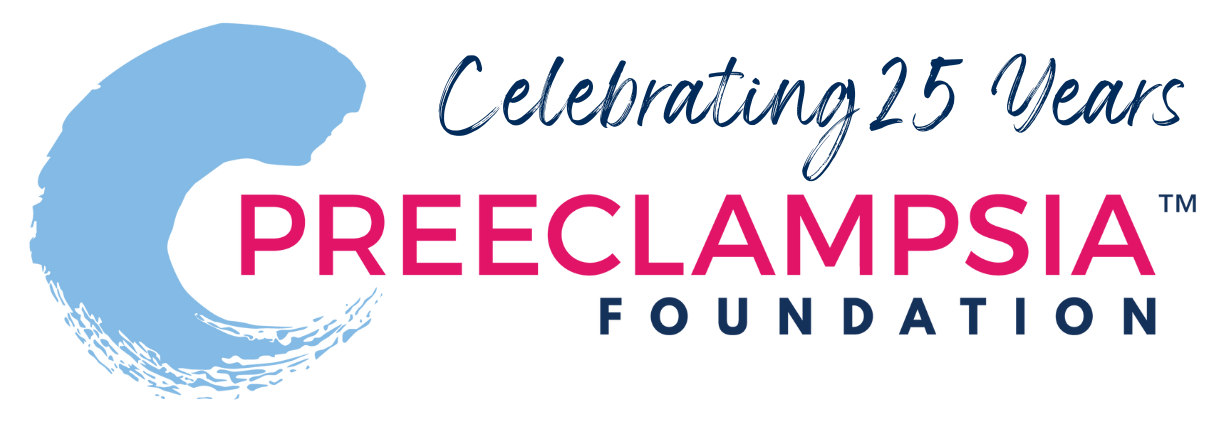
New Guidelines in Preeclampsia Diagnosis and Care Include Revised Definition of Preeclampsia
 The American College of Obstetricians and Gynecologists (The College) Task Force on Hypertension in Pregnancy published its report, Hypertension in Pregnancy, on November 2013. This report on the diagnosis and management of preeclampsia is the culmination of two years of hard work by the 16-member ACOG task force, on which the Preeclampsia Foundation represented the patient's point of view.
The American College of Obstetricians and Gynecologists (The College) Task Force on Hypertension in Pregnancy published its report, Hypertension in Pregnancy, on November 2013. This report on the diagnosis and management of preeclampsia is the culmination of two years of hard work by the 16-member ACOG task force, on which the Preeclampsia Foundation represented the patient's point of view.
"This Task Force report changes the paradigm that we use in diagnosing preeclampsia from one that is dependent on new onset hypertension and proteinuria," said James N. Martin, Jr., MD, who is on the medical advisory board of the Preeclampsia Foundation and past president of The College. "The problem is that many patients with preeclampsia don't have enough proteinuria to meet the former criteria, so their diagnosis and treatment is delayed."
The revised definition of preeclampsia is just one of many improvements made to ACOG's guidelines based on scientific evidence.
The new guidelines are presented in a 99-page report written for the College'smprofessional members. The Preeclampsia Foundation is in the process of developing a patient guide to the new ACOG guidelines for publication this coming winter. The patient overview will be a PDF available online to help patients understand the changes and what to expect if they experience hypertension in pregnancy. A planned second edition is to include notes about international guidelines, such as those coming from the World Health Organization(WHO) and the soon-to-be-published guidelines from the Society of Obstetricians and Gynecologists of Canada (SOGC).
The Revised Definition of Preeclampsia
According to the new ACOG guidelines, the diagnosis of preeclampsia no longer requires the detection of high levels of protein in the urine (proteinuria). Evidence shows organ problems with the kidneys and livers can occur without signs of protein, and that the amount of protein in the urine does not predict how severely the disease will progress. Prior to this time, most healthcare providers traditionally adhered to a rigid diagnosis of preeclampsia based on blood pressure and protein in the urine(proteinuria).
Preeclampsia is now to be diagnosed by persistent high blood pressure that develops during pregnancy or during the postpartum period that is associated with a lot of protein in the urine or the new development of decreased blood platelets, trouble with the kidney or liver, fluid in the lungs, or signs of brain trouble such as seizures and/or visual disturbances.
Other Big Changes in Diagnosis and Management
Evidence tells us that preeclampsia is a dynamic process. Diagnosing a woman's condition as "mild preeclampsia" is not helpful because it is a progressive disease, progressing at different rates in different women. Appropriate care requires frequent re-evaluation for severe features of the disease and appropriate actions outlined in the new guidelines.
Mild to moderate high blood pressure (140-159 mm Hg systolic or 90-159 mm Hg diastolic measured on two occasions at least four hours apart) warrants close evaluation and monitoring. High blood pressure greater than or equal to 160 mm Hg systolic or greater than or equal to 110 mm Hg diastolic is a feature of severe preeclampsia.
To prevent eclampsia (seizures), magnesium sulfate should be given if your blood pressure is 160/110 or higher. If your blood pressure is less than 160/110 and you have other severe symptoms that usually precede seizures, you should be given magnesium sulfate. Severe hypertension can be confirmed within a short interval (minutes) to facilitate timely antihypertensive therapy.
Guidelines for the timing of delivery have been modified based on data indicating best outcomes for mother and baby. One of the biggest changes in preeclampsia management relates to the timing of delivery in women with preeclampsia without severe features. Studies suggest that the best time of delivery is at 37 weeks of gestation. It has been known for many years that preeclampsia can worsen or become apparent for the first time after delivery. The new guidelines include specific recommendations to improve outcomes for women who have postpartum preeclampsia.
Evidence firmly tells us that preeclampsia is associated with later life cardiovascular disease (CVD), and the ACOG report calls for research to learn how to use this information to help patients.
A new recommendation is to educate all pregnant and postpartum patients about the signs and symptoms of preeclampsia. The Preeclampsia Foundation advocated for this addition based on the evidence of its own research study that has just been published.
Survivors Applaud
Comments on the Preeclampsia Foundation's Facebook page indicate the new diagnostic guidelines are perceived as a cause for celebration among survivors of preeclampsia. Here is a sample of your thoughts:
"Great news - but bittersweet for so many of us who did not have all the classic symptoms of PE and/or HELLP and who struggled trying to get people to listen to us that something was not right." ~ Amanda G."I too didn't spill protein until I was in dire straits and nearly dead from Preeclampsia and HELLP! So glad to see this change to the guidelines!"~Brenda S.
Related Articles

Your story is needed to improve outcomes for moms like you. Add your voice to critical preeclampsia research to ensure that every story is heard.

Frequently asked questions about the Preeclampsia Registry, a patient-driven registry and biobank.

The Preeclampsia Foundation offers research funding, study recruitment, and other patient engagement services to researchers.

We provide research grant funding to advance progress towards detection, prevention, or treatment of preeclampsia, HELLP syndrome, and other hypertensive disorders of pregnancy.

While the foundations of preeclampsia are believed to develop in the early stages of pregnancy, the current screening process occurs at 20 weeks, nearly half way through the second trimester. When cli...

Research suggests that preeclampsia may develop in a two-stage process. The first stage involves challenges to the way that the placenta implants and grows. In a normal pregnancy, a type of placental...

The risk of developing hypertension and cardiovascular disease (CVD) significantly increases for patients who experience gestational hypertension, preeclampsia, or other hypertensive disorders of preg...

Cerebral complications from preeclampsia and eclampsia are a major cause of maternal mortality and long-term neurological impact. Understanding pathophysiology (changes in how the body works as a resu...

The Preeclampsia Foundation is seeking Letters of Intent for the Peter Joseph Pappas Research Grants funding program, designed to accelerate preeclampsia research. The ultimate goal of this grant prog...

